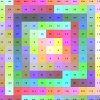Number Theory Seminar
A positive integer is called a congruent number if it is the area of a right-angled triangle, all of whose sides have rational length. A celebrated theorem due to Tunnell gives a criterion for a positive integer to be congruent (under the BSD conjecture).
We show that if a square-free and odd (respectively, even) positive integer $n$ is a congruent number, then
$$\#\{(x,y,z) \in \mathbb{Z}^3|n=x^2+2y^2+32z^2\}=\#\{(x,y,z) \in \mathbb{Z}^3|n=2x^2+4y^2+9z^2-4yz\},$$
respectively,
$$\#\{(x,y,z) \in \mathbb{Z}^3|\frac{n}{2}=x^2+4y^2+32z^2\}=\#\{(x,y,z) \in \mathbb{Z}^3|\frac{n}{2}=4x^2+4y^2+9z^2-4yz\}.$$
If we assume that the weak Birch--Swinnerton-Dyer conjecture is true for the elliptic curves $E_{n}:y^2=x^3-n^2x$, then, conversely, these equalities imply that $n$ is a congruent number.
We shall also discuss some applications.
